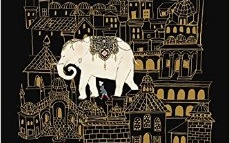In its depiction of a crumbling utopia, Aldous Huxley’s 1932 classic “Brave New World” poses moral quandaries that remain relevant today. In their adaptation of the novel, the Harvard-Radcliffe Modern Dance Company has found their own way to make connections between Huxley’s futuristic world and our present one. Staged in the black box of the Loeb Ex from April 6 to 8, the show will immerse the audience in an emotional experience of dance and projection. Each piece in the multi-part show will convey a predominant theme rather than a specific chapter.
Directors Sarah E. Coady ’19 and Gabe S. Martinez ’18 wanted to return to the narrative as an inspiration to the show after the success of their 2015 fall adaptation of Homer’s “Odyssey.” They decided to use Huxley’s book because of its timelessness and relevance. “I think a lot of the themes about an over-powerful state and questions about one’s identity… are very relevant to today’s world,” says Coady.
The show consists of twelve pieces in diverse styles accompanied by a wide range of music, each chosen to encapsulate the eerie, dystopian environment of the novel’s world. In order to maximize space, the dances are not staged within actual sets but instead are framed by hanging sheets composed of many individual threads. During the performances, these moving plans display projections of abstract shapes, images, and colors to evoke a feeling of uneasiness. The lighting also aims to create the distinct ambience present in the novel. “A lot of choreographers requested deep red, somber lighting and stark, almost fluorescent lighting. They were going for dystopian isolation, as well as mysterious, dark vibes,” says technical director Tiffany Y. Lau ’19.
Another difficulty of taking such a complex and richly symbolic novel is presenting it as a performance without words. “[The dances] bring the themes to life in an abstract way … If you’ve read the book our goal is to make you feel like how you feel when you read the book,” says Coady. Choreographers looked for movement that encapsulated themes present in the novel, particularly through the interactions between the dancers. One dance, called “D I S T A N C E,” about the attraction between two characters, uses certain movements to embody this relationship. “There is a lot filling the space, but with hands not quite touching,” says dancer Margaret E. Reynolds ’20. “There are a lot of interactions that are just missed or contrasting with each other … There is a lot of tension between spaces,” she says.
Ultimately, the works endeavor to make the audience appreciate Huxley’s story and to form connections between its unique world and our present one. “I hope everyone is intrigued enough that they will go home and read the book, because it is fantastic. I hope we are really able to convey the themes of identity, all-powerful state, and censorship in our new, changing world, how this novel written in the 1930s can connect to today,” says Coady.
—Staff writer Aline G. Damas can be reached at aline.damas@thecrimson.com.
Read more in Arts
‘13 Reasons Why’ Brings New Depth and Artistry to NetflixRecommended Articles
-
Radcliffe Fellow Talks Novel, Nuances of Sri Lankan PoliticsRadcliffe Institute fellow V.V. Ganeshananthan ’02 discussed the process of writing her upcoming novel about Sri Lankan politics on Wednesday afternoon.
-
 'Architect's Apprentice' a Detailed but Imperfect Construction
'Architect's Apprentice' a Detailed but Imperfect Construction -
‘The Physics of Sorrow’ Worth Getting Lost InBulgarian writer Georgi Gospodinov’s “The Physics of Sorrow” unites formal experimentation with emotional resonance in a compelling exploration of how and why humans tell stories.
-
Franzen’s 'Purity' Muddied by Preachiness, LengthAlthough Franzen succeeds in rendering several exquisite passages and characters on a micro scale, “Purity” ultimately struggles to pack a punch on a macro scale, thanks in part to its lagging beginning.
-
'Philosophical Toys' TantalizesFor all of its flaws, “Philosophical Toys” ultimately presents an engaging, modern take on the human obsession with the tangible.













